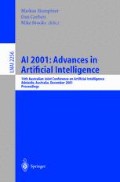Abstract
Evolutionary Artificial Neural Networks (EANN) have been a focus of research in the areas of Evolutionary Algorithms (EA) and Artificial Neural Networks (ANN) for the last decade. In this paper, we present an EANN approach based on pareto multi-objective optimization and differential evolution augmented with local search. We call the approach Memetic Pareto Artificial Neural Networks (MPANN). We show empirically that MPANN is capable to overcome the slow training of traditional EANN with equivalent or better generalization.
Access this chapter
Tax calculation will be finalised at checkout
Purchases are for personal use only
Preview
Unable to display preview. Download preview PDF.
References
H.A. Abbass, R. Sarker, and C. Newton. A pareto differential evolution approach to vector optimisation problems. Congress on Evolutionary Computation, 2:971–978, 2001.
C.L. Blake and C.J. Merz. UCI repository of machine learning databases, http://www.ics.uci.edu/~mlearn/mlrepository.html. University of California, Irvine, Dept. of Information and Computer Sciences, 1998.
C.A. Coello. A comprehensive survey of evolutionary-based multiobjective optimization techniques. Knowledge and Information Systems, 1(3):269–308, 1999.
S. Fahlman and C. Lebiere. The cascade correlation learning architecture. Technical Report CMU-CW-90-100, Canegie Mellon University, Pittsburgh, PA, 1990.
D.B. Fogel. Evolutionary Computation: towards a new philosophy of machine intelligence. IEEE Press, New York, NY, 1995.
D.B. Fogel, E.C. Wasson, and E.M. Boughton. Evolving neural networks for detecting breast cancer. Cancer letters, 96(1):49–53, 1995.
D.B. Fogel, E.C. Wasson, and V.W. Porto. A step toward computer-assisted mammography using evolutionary programming and neural networks. Cancer letters, 119(1):93, 1997.
S. Haykin. Neural networks-a comprehensive foundation. Printice Hall, USA, 2 edition, 1999.
J. Horn, N. Nafpliotis, and D.E. Goldberg. A niched pareto genetic algorithm for multiobjective optimization. Proceedings of the First IEEE Conference on Evolutionary Computation, 1:82–87, 1994.
D.J. Janson and J.F. Frenzel. Application of genetic algorithms to the training of higher order neural networks. Systems Engineering, 2:272–276, 1992.
D.J. Janson and J.F. Frenzel. Training product unit neural networks with genetic algorithms. IEEE Expert, 8(5):26–33, 1993.
H. Kitano. Designing neural networks using genetic algorithms with graph generation system. Complex Systems, 4(4):461–476, 1990.
J. Knowles and D. Corne. Approximating the nondominated front using the pareto archived evolution strategy. Evolutionary Computation, 8(2):149–172, 2000.
Y. LeCun, J.J. Denker, and S.A. Solla. Optimal brain damage. In D. Touretzky, editor, Advances in Neural Information Processing Systems. Morgan Kaufmann, 1990.
V. Maniezzo. Genetic evolution of the topology and weight distribution of neural networks. IEEE Transactions on Neural Networks, 5(1):39–53, 1994.
F. Menczer and D. Parisi. Evidence of hyperplanes in the genetic learning of neural networks. Biological Cybernetics, 66:283–289, 1992.
D. Michie, D.J. Spiegelhalter, and C.C. Taylor. Machine learning, neural and statistical classification. Ellis Horwood, 1994.
P. Moscato. Memetic algorithms: a short introduction. In D. Corne, M. Dorigo, and F. Glover, editors, New ideas in optimization, pages 219–234. McGraw-Hill, 1999.
V.W. Porto, D.B. Fogel, and L.J. Fogel. Alternative neural network training methods. IEEE Expert, 10(3):16–22, 1995.
J.C.F. Pujol and R. Poli. Evolving the topology and the weights of neural networks using a dual representation. Applied Intelligence, 8(1):73–84, 1998.
D.E. Rumelhart, G.E. Hinton, and R.J. Williams. Learning internal representations by error propagation. In J.L. McClelland D.E. Rumelhart and the PDP Research Group Eds, editors, Parallel Distributed Processing: Explorations in the Microstructure of Cognition., Foundations, 1, 318,. MIT Press Cambridge, 1986.
R. Sarker, H.A. Abbass, and C. Newton. Solving multiobjective optimization problems using evolutionary algorithm. The International Conference on Computational Intelligence for Modelling, Control and Automation (CIMCA’2001), Los Vegas, USA, 2001.
J.D. Schaffer. Multiple objective optimization with vector evaluated genetic algorithms. Genetic Algorithms and their Applications: Proceedings of the First International Conference on Genetic Algorithms, pages 93–100, 1985.
R. Storn and K. Price. Differential evolution: a simple and efficient adaptive scheme for global optimization over continuous spaces. Technical Report TR-95-012, International Computer Science Institute, Berkeley, 1995.
P. Werbos. Beyond regression: new tools for prediction and analysis in the behavioral sciences. PhD thesis, Harvard University, 1974.
W. Yan, Z. Zhu, and R. Hu. Hybrid genetic/bp algorithm and its application for radar target classification. Proceedings of the 1997 IEEE National Aerospace and Electronics Conference, NAECON, pages 981–984, 1997.
X. Yao. Evolutionary artificial neural networks. International Journal of Neural Systems, 4(5):203–222, 1993.
X. Yao. A review of evolutionary artificial neural networks. International Journal of Intelligent Systems, 8(4):529–567, 1993.
X. Yao. Evolving artificial neural networks. Proceedings of the IEEE, 87(9):1423–1447, 1999.
X. Yao and Y. Liu. Making use of population information in evolutionary artificial neural networks. IEEE Trans. on Systems, Man, and Cybernetics, Part B: Cybernetics, 28(3):417–425, 1998.
X. Yao and Y. Liu. Towards designing artificial neural networks by evolution. Applied Mathematics and Computation, 91(1):83–90, 1998.
E. Zitzler and L. Thiele. Multiobjective evolutionary algorithms: A comparative case study and the strength pareto approach. IEEE Transactions on Evolutionary Computation, 3(4):257–271, 1999.
Author information
Authors and Affiliations
Editor information
Editors and Affiliations
Rights and permissions
Copyright information
© 2001 Springer-Verlag Berlin Heidelberg
About this paper
Cite this paper
Abbass, H. (2001). A Memetic Pareto Evolutionary Approach to Artificial Neural Networks. In: Stumptner, M., Corbett, D., Brooks, M. (eds) AI 2001: Advances in Artificial Intelligence. AI 2001. Lecture Notes in Computer Science(), vol 2256. Springer, Berlin, Heidelberg. https://doi.org/10.1007/3-540-45656-2_1
Download citation
DOI: https://doi.org/10.1007/3-540-45656-2_1
Published:
Publisher Name: Springer, Berlin, Heidelberg
Print ISBN: 978-3-540-42960-9
Online ISBN: 978-3-540-45656-8
eBook Packages: Springer Book Archive

